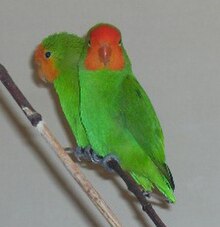Red-headed lovebird
| Red-headed lovebird | |
|---|---|

| |
| Male (foreground) and female | |
| Scientific classification | |
| Domain: | Eukaryota |
| Kingdom: | Animalia |
| Phylum: | Chordata |
| Class: | Aves |
| Order: | Psittaciformes |
| Family: | Psittaculidae |
| Genus: | Agapornis |
| Species: | A. pullarius
|
| Binomial name | |
| Agapornis pullarius | |
| Synonyms | |
|
Psittacus pullarius Linnaeus, 1758 | |
The red-headed lovebird (Agapornis pullarius) also known as the red-faced lovebird is a member of the genus Agapornis, a group commonly known as lovebirds. Like other lovebirds it is native to Africa.
Description
The red-headed lovebird is a 15 cm (6 inches) long, mostly green parrot. It has a well demarcated red area on its head extending from the top of the beak, over the forehead to mid-crown, and extending to the left and right up to the eyelid margins. It has grey feet. The underside of the wings is a lighter green. The female has orange head colouring, which is less well demarcated than the male's red head. The adult male has a red beak while the female's is a paler red.[2]
Distribution and habitat
It has a patchy distribution across the African tropical rainforest.
Breeding
It makes its nest in a termites nest usually in a tree or sometimes on the ground. To make a nest the female digs a tunnel up to a length of 30 cm (12 in) in the termites nest in a colony with other lovebirds.[2]
Aviculture
It is difficult to breed in captivity because it has to burrow to make its nest and the nest chamber needs to be heated to about 27 °C (81 °F); however, they can be induced to burrow into cork to build a nest. It is a very nervous species.[2]
References
- ^ BirdLife International (2012). "Agapornis pullarius". IUCN Red List of Threatened Species. 2012. Retrieved 26 November 2013.
{{cite journal}}: Invalid|ref=harv(help) - ^ a b c Le Breton, Kenny. Lovebirds...getting started. USA: T.F.H. Publications. pp. 85–88. ISBN 0-86622-411-4.
External links
- "Species factsheet: Agapornis pullarius". BirdLife International (2008). Retrieved 9 July 2008.
- Pullaria.info

